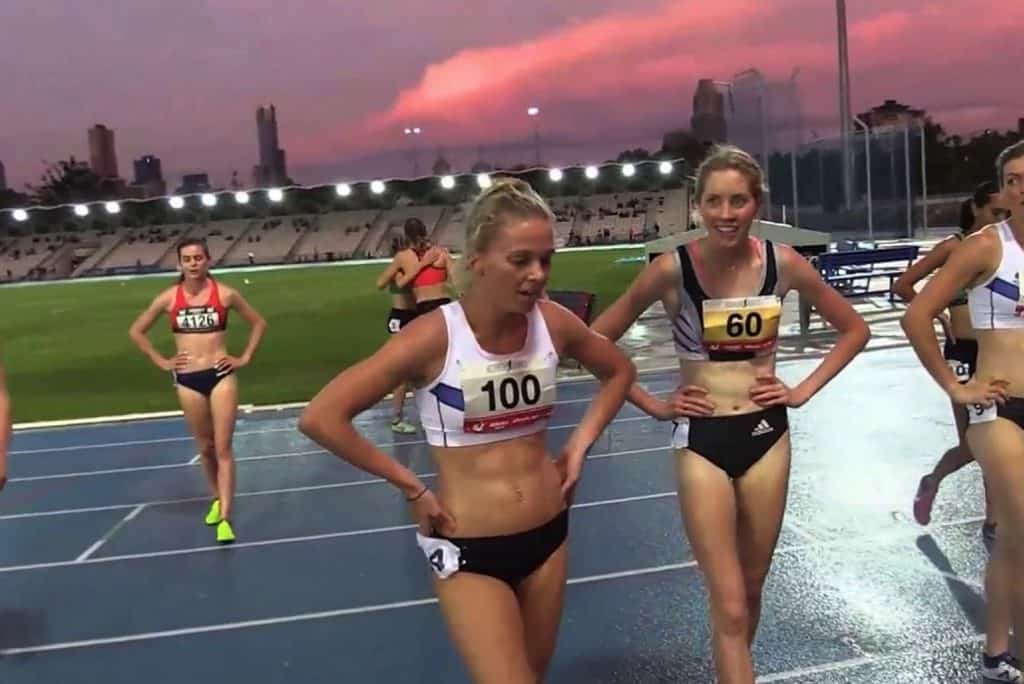A few days back I officiated at a Victorian Milers Club meeting, the second of the 2018-19 season. Over 320 athletes participated in a total of 29 races over 800 (17 races) and 1500 metres (12).
Not bad for a little organisation which started with just 71 competitors over six races – all at 1500 – in its first competition meeting on 27 October, 2005. For our second meeting that year we added the 800 distance and that has been the pretty-well unchanged template ever since: graded races over two distances for as many who want to run.
In one meeting last year entries peaked at almost 450 and 413 actually competed. For the first time, all five meetings for the 2017-18 season had over 300 entries.
Like Topsy, it seems the VMC has just grown, largely without control or intention.
The Victorian Milers Club was formed in the winter of 2005 with a model based largely on the British Milers Club. The aim was to foster middle-distance running in Victoria both for the elite and the masses. Anyone who wanted to run was free to enter.
Like many good ideas in Australian distance running, famed coach Pat Clohessy sparked the initiative. Former middle-distance great Steve Ovett lived on the Gold Coast then and ‘Clo’ was keen to get him involved in giving local Queensland running a boost. Beyond enthusiastic endorsement of the concept, that largely didn’t happen, but a couple of Queensland Milers Club meeting were held at the University of Queensland track.
Deciding any good idea is worth copying, a group of us got together in Melbourne to foster a similar club. Initially, we formed a committee on which Trevor Vincent, and coaches Peter Fortune, Bruce Scriven and Nikki Frey were all involved. Justin Rinaldi, coach of Joseph Deng and Peter Bol, was another member, along with most of us who comprise the current committee.
Longevity has been a feature of the VMC. We’ve lost the coaching component of the committee, but most of us have been there since the first season. We’ve formed fruitful links with Athletics Victoria. There have been issues – there always are – but the liaison has overwhelmingly been fruitful and harmonious.
We had five officials join us from the start. Timekeepers Harold and Pat Robinson and Allan Glover, recorder Yvonne Glover and starter Brendan Ferrari. Announcer (and master statistician) Paul Jenes was another foundation member. Allan passed away a couple of years back, Harold Robinson has retired, but Pat, Yvonne, Brendan and Paul are still there, meeting after meeting.
Some of our competitors have shown marathon endurance as well as middle-distance speed. Simon Fitzpatrick, a national-class 800 metres runners, competed in the second meeting in 2005-06 (the first to offer an 800). Thirteen years later, almost to the day, he went around again this week, breaking two minutes in third place in the C-race.
As already said, if you asked any of us how this came about, we wouldn’t quite know. We could identify some things we’ve got right – a simple program, which runs to time, and in which every runner from the fastest to the slowest gets to race against opponents of similar standards. We’ve competed as a twilight/night meeting, the best part of even the hottest summer days.
Some other things just fell in to place. Our third meeting, in March, 2006, was timed to attract athletes competing in the Melbourne Commonwealth Games. They didn’t turn up in huge numbers, but England’s Nick McCormick and Guernsey’s Lee Merrien both ran. McCormick is still seventh on the VMC men’s all-time 800 list. A good crowd watched from trackside, too, including the legendary Brendan Foster, out here to comment on the Games for the BBC and, of course, because athletics . . .
At our previous meeting, local athlete Louis Rowan had achieved the qualifying time for Australian selection in the 1500 metres – running a hand-timed 3:40.0, which remains our VMC record. That helped establish a reputation with the elite runners. The following year, Jeff Riseley began his emergence from club runner to international class with a 1:49.0 breakthrough at 800.
For a long time VMC women’s participation lagged behind the men’s. At the very first meeting, there were four heats of the 1500 for men, just two for women. The second heat had just four finishers, though it was won by Madeline Pape who went on to become one of only five Australian women to have broken two minutes for 800 and to represent at both world championships and Olympic Games.
Thankfully, women’s participation is now on pretty much an even footing with men’s (though it would be pleasing to have to drop the ‘pretty much’ qualifier). VMC 800s in recent times have boasted national-class women’s fields in the A-races with the likes of Georgia Griffith, Anneliese Rubie, Kelly Hetherington, Tamsyn Manou and Abbey de la Motte all competing. Griffith, Small, Carley Thomas and de la Motte were the first four in one recent 800.
Even more pleasing, though, has been the continued growth in participation. We cracked the 100 barrier with 110 in our second meeting of our first season; the following year every meeting was over 100 with a high of 194.
The first 200-plus came in February 2009, and the first season in which each of the five meetings had over 200 was 2013-14. Now it’s 300-plus and we are bursting at the seams.
None of us can go on forever, but hopefully this level of participation, and the support of some of our best middle-distance athletes can, and will.
